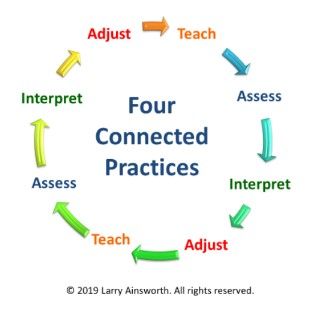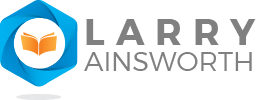TIMELESS PRACTICES TO IMPROVE STUDENT LEARNING
Supporting educators and leaders in their important work of helping every student become a confident and successful learner
How to Construct an Integrated Teaching and Learning System
By Larry Ainsworth
Are your professional practices to improve teaching and student learning all intentionally connected?
Constructing an educational framework that includes all necessary components is a complex endeavor. There are so many moving parts to take into consideration (standards, assessments, instructional strategies, curriculum programs, data analysis, and all their related aspects) that construction efforts can often feel—and become—fragmented and disconnected. But no more!
The Pre-Construction Blueprint
Here’s how to build a comprehensive and fully aligned teaching and learning system that intentionally connects all the key components in a step-by-step construction sequence.
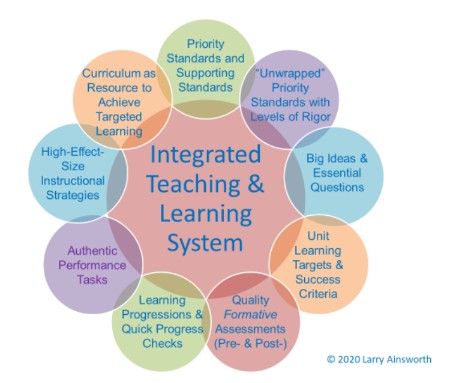
This pre-construction blueprint begins with a sharp focus on the prioritization of standards as the system’s foundation and, following a clockwise progression, ends with the use of curriculum as the means for helping educators assist students in learning the Priority Standards for each unit of study.
Each of these components is essential in the design of an integrated teaching and learning system. But to effectively carry out the work needed to create all these interrelated parts takes time. I’ve grouped these various elements into five “stages of construction” to ensure that the process is thoughtfully “built” at a doable pace and doesn’t overwhelm the “builders”!
Constructing the System—In Five Stages
The five construction stages are (1) Building the Foundation; (2) Beginning Construction; (3) Continuing Construction; (4) Nearing Completion; and (5) Finishing Construction. Each stage includes a focus on developing one component at a time, presented here in the production sequence.
Stage 1: Building the Foundation
1. Prioritize the Standards—Identify in each grade level and course the most rigorous standards that will require the greatest emphasis in instruction and assessment.
2. Name the Units and Assign the Priority Standards— Name the units of study for each grade and course and then assign matching Priority Standards to those units.
3. Assign the Supporting Standards—Identify the less rigorous supporting standards that connect or relate to the Priority Standards for each unit topic.
4. Prepare a Yearlong Pacing Calendar—Create a yearlong (or course long) schedule for administering all of the planned units of study in each grade level or course.
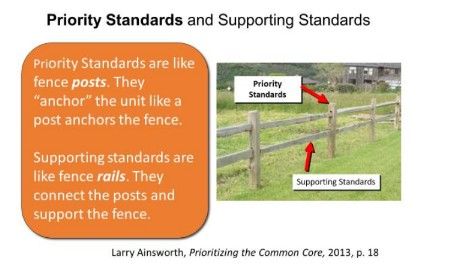
Stage 2: Beginning Construction
5. “Unwrap” the Priority Standards for Greater Clarity—Analyze and deconstruct the wording of each Priority Standard within the units of study to pinpoint exactly what students need to know and be able to do.
6. Identify the Levels of Cognitive Rigor—Determine Bloom’s & Depth of Knowledge (DOK) levels for each “unwrapped” skill-concept pair (i.e., ANALYZE author’s point of view—DOK Level 2)
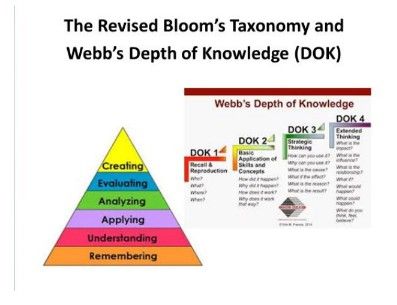
7. Decide on the Big Ideas and Essential Questions. Decide on the Big Ideas (important understandings, student “aha’s”) derived from the “unwrapped” concepts and skills for the unit of study. Write Essential Questions that will engage students to discover for themselves the related Big Ideas and state them in their own words by the end of the unit.
8. Write the “Unwrapped” Priority Standards as Student-Friendly Learning Targets—Without Losing the Rigor. These are the unit learning targets students are to achieve. Then identify the unit’s academic vocabulary.
9. Write the Success Criteria with Specific Wording. Objectively worded performance descriptors will show students exactly how to achieve the unit learning targets.
Stage 3: Continuing Construction
10. Create Quality Formative Assessments to “Bookend” Each Instructional Topic or Unit—Create the pre- and post-unit assessments and scoring guides matched to the identified rigor of the “unwrapped” Priority Standards.

Stage 4: Nearing Completion Construction
11. Determine the Learning Progressions—the “building blocks” of rigor, from simple to complex, that scaffold student learning to the Priority Standards. These are the lesson-specific learning targets sequenced for daily instruction.
12. Plan Quick Progress Checks Matched to Learning Progressions. These short, formative assessments (think “exit slips”), aligned to the concepts and skills on the unit post-assessment, provide immediate evidence of student learning of the targeted learning progressions.
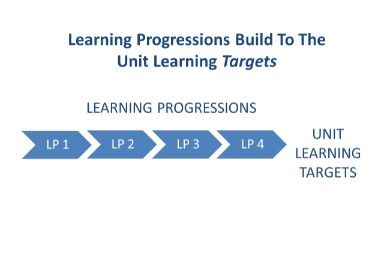
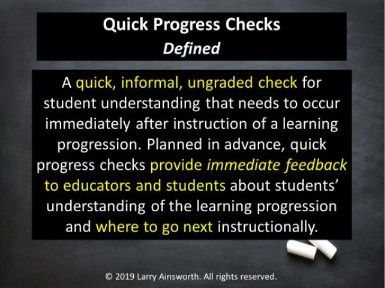
13. Create Authentic Performance Tasks. Plan authentic performance tasks directly based on the “unwrapped” concepts and skills with real-world applications that challenge students to utilize deep thought, investigation, and communication.
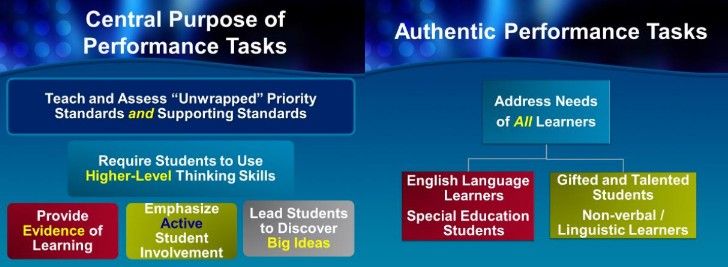
Stage 5: Finishing Construction
14. Select High-Effect-Size Instructional Strategies. Use high-effect-size instructional strategies (those shown to produce one or more years of student learning during a single academic school year) to teach the learning progressions in daily lessons and learning activities.
15. Use Curriculum as a Key Resource—the means to the end—for helping students learn the “unwrapped” Priority Standards and learning progressions and to prepare them for success on the unit post-assessment. Curriculum provides the organizational plan and instructional resources teachers use to achieve the intended student learning.
When the integrated teaching and learning system units are complete and ready to implement, individual teachers and/or Professional Learning Community (PLC) grade- and course-level teams analyze and interpret assessment results from the unit post-assessment to determine whether students have achieved the “unwrapped” Priority Standards in focus. They then use these assessment results as credible evidence of what they need to do next in order to adjust instruction in order to ensure that all students succeed!
